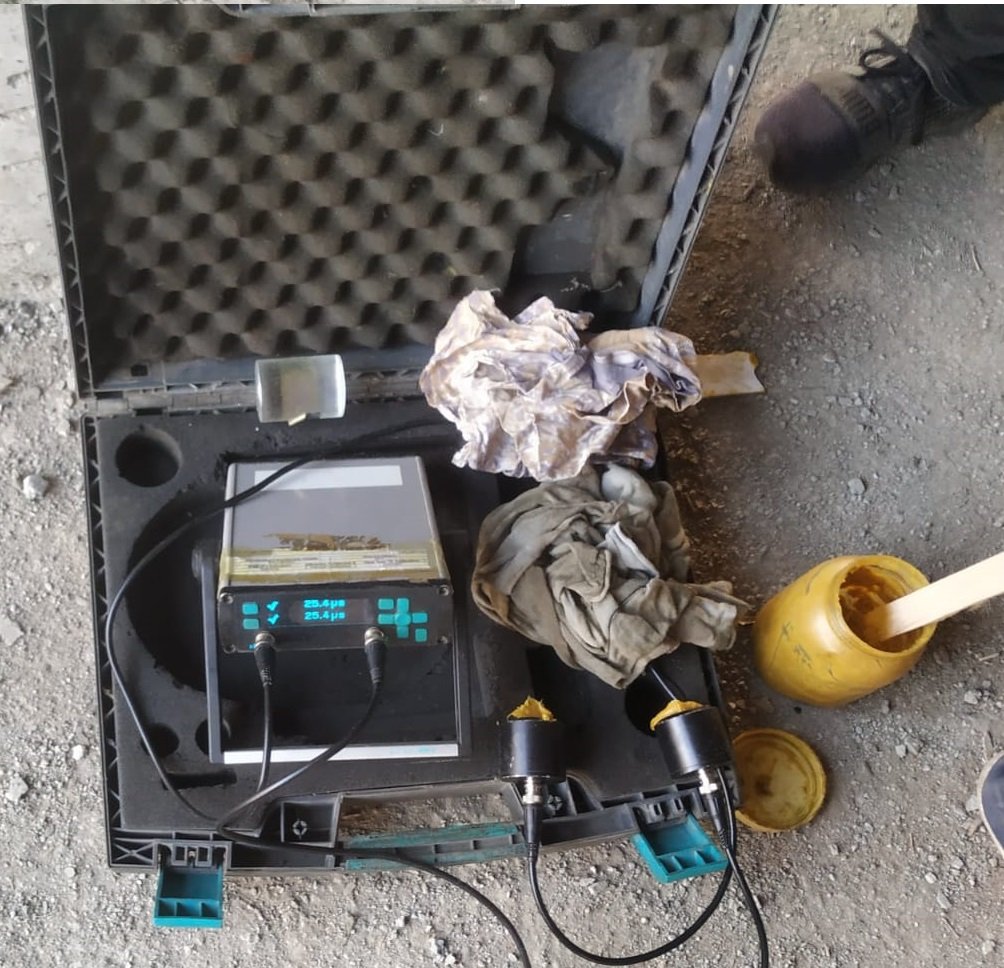Objectives and significance: –
Ultrasonic Pulse Velocity test is non destructive test like Rebound Hammer Test. An ultrasonic pulse velocity (UPV) test is an in-situ, nondestructive test to check the quality of concrete. he strength and quality of concrete or rock is assessed by measuring the velocity of an ultrasonic pulse passing through a concrete structure. It is used for
- Understanding Homogeneity of concrete
- Presence of cracks in concrete
- Presence of voids in concrete
- Quality of concrete as per desired concrete quality
- values of dynamic elastic modulus of the concrete
Aim: –
To check quality of concrete by using Ultrasonic Pulse Velocity Test
Factors Affecting: –
- Path Length
- Shape of specimen
- Size of the member
- Temperature of Concrete
- Stress in Concrete
- Reinforced Bars
- Surface Conditions
- Moisture Content
Apparatus: –
Ultrasonic Pulse Velocity Meter. The apparatus for ultrasonic pulse velocity measurement shall consist of the following:
a) Electrical pulse generator,
b) Transducer – one pair,
c) Amplifier, and
d) Electronic timing device.


Procedure:-
- In this test method, the ultrasonic pulse is produced by the transducer which is held in contact with one surface of the concrete member under test. After traversing a known path length L in the concrete, the pulse of vibrations is converted into an electrical signal by the second transducer held in contact with the other surface of the concrete member and an electronic timing circuit enables the transit time (T) of the pulse to be measured. The pulse velocity (V) is given by:
V = L/T - Once the ultrasonic pulse impinges on the surface of the material, the maximum energy is propagated at right angles to the face of the transmitting transducer and best results are, therefore, obtained when the receiving transducer is placed on the opposite face of the concrete member (direct transmission or cross probing). However, in many situations two opposite faces of the structural member may not be accessible for measurements. In such cases, the receiving transducer is also placed on the same face of the concrete members (surface probing). Surface probing is not so efficient as cross probing, because the signal produced at the receiving transducer has an amplitude of only 2 to 3 percent of that produced by cross probing and the test results are greatly influenced by the surface layers of concrete which may have different properties from that of concrete inside the structural member. The indirect velocity is invariably lower than the direct velocity on the same concrete element. This difference may vary from 5 to 20 percent depending largely on the quality of the concrete under test. For good quality concrete, a difference of about 0.5 km/ sec may generally be encountered.
- To ensure that the ultrasonic pulses generated at the transmitting transducer pass into the concrete and are then detected by the receiving transducer, it is essential that there be adequate acoustical coupling between the concrete and the face of each transducer. Typical couplants are petroleum jelly, grease, liquid soap and kaolin glycerol paste. If there is very rough concrete surface, it is required to smoothen and level an area of the surface where the transducer is to be placed. If it is necessary to work on concrete surfaces formed by other means, -for example troweling, it is desirable to measure pulse velocity over a longer path length than would normally be used. A minimum path length of 150 mm is recommended for the direct transmission method involving one unmoulded surface and a minimum of 400 mm for the surface probing method along an unmoulded surface.
- The natural frequency of transducers should preferably be within the range of 20 to 150 kHz. Generally, high frequency transducers are preferable for short path lengths and low frequency transducers for long path lengths. Transducers with a frequency of 50 to 60 kHz are useful for most all-round applications.
- Since size of aggregates influences the pulse velocity measurement, it is recommended that the minimum path length should be 100 mm for concrete in which the nominal maximum size of aggregate is 20 mm or less and 150 mm for concrete in which the nominal maximum size of aggregate is between 20 to 40 mm.
- In view of the inherent variability in the test results, sufficient number of readings are taken by dividing the entire structure in suitable grid markings of 30 x 30 cm or even smaller. Each junction point of the grid becomes a point of observation.
- Transducers are held on corresponding points of observation on opposite faces of a structural element to measure the ultrasonic pulse velocity by direct transmission, i.e., cross probing. If one of the faces is not- accessible, ultrasonic pulse velocity is measured on one face of the structural member by surface probing.
- Surface, probing in general gives lower pulse velocity than in case of cross probing and depending on number of parameters, the difference could be of the order of about 1 km/sec.
Result and Calculations: –
| S. No. | Pulse velocity by Cross Probing (km/sec) | Concrete Quality Grading |
|---|---|---|
| 1 | Above 4.5 | Excellent |
| 2 | 3.5 to 4.5 | Good |
| 3 | 3.0 to 3.5 | Medium |
| 4 | Below 3.0 | Doubtful |
Velocity Criterion for Concrete Quality Grading.